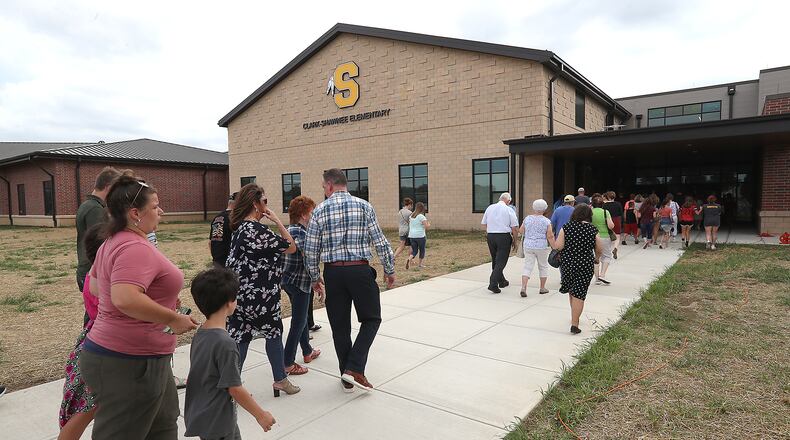If passed, the five-year levy would raise around $3.1 million each year. For a resident with $50,000 in annual taxable income, the tax would cost $500 per year.
“You’ve got longtime residents who have paid off their homes but they still pay a property tax every year on an item that they’ve had paid off for several years,” Kuhn said. “So we don’t want our retired community to be taxed out of their residences.”
District financial picture
Clark-Shawnee schools’ most recent five-year financial forecast shows total revenues grew by $2 million recently from $20.77 million in 2021-2022, to $22.77 million in 2023-2024. But total expenditures grew slightly faster, from $20.77 million to $23.14 million in that same time period.
The district was about $375,000 in the red each of the past two years and was projecting larger annual deficits of $1.35 million and $1.09 million the next two years, according to last fall’s forecast document. Most of that was due to a projected increase in spending, largely from salaries and benefits.
At the end of last school year, Clark-Shawnee had about 23% of a year’s spending in the bank, the lowest of the seven Clark County public school districts, and about half the average balance of school districts in the entire Miami Valley.
The school district last passed an operating tax levy for new money in 2014.
Residents previously passed a bond issue to fund new school buildings, and Kuhn emphasized that those funds could only be used for the buildings, not for daily operating expenses.
Kuhn said 94% of the district’s revenue comes from state funding and local property taxes.
Types of tax levies, possible state law changes
Clark-Shawnee elected to seek an earned income tax levy rather than property tax given the tax abatement on the Bridgewater development and incoming Melody Parks development, the superintendent said.
The tax abatement, which was approved by Springfield city, means a portion of property taxes are diverted to the developer, so the school would miss out on some of those funds. State law currently requires all earned income taxes go to the schools.
School districts are contending with proposed state legislation regarding property taxes and school funding, Kuhn said, which makes planning for the future difficult.
“There are multiple bills, I think between nine to 11 pieces of legislation that have been introduced or in the works that would adjust property tax procedures in Ohio,” Kuhn said. “That makes it hard for school treasurers to plan. How do you plan when you have a dozen or so scenarios that could come to fruition? And none of them look good for schools.”
The district is currently working on an updated five-year financial forecast to be filed in May ”that will reflect some of these things that we didn’t know in November," he said.
Schools make adjustments
The district has 13 upcoming resignations — the majority being retirements — and will replace only seven of those positions, Kuhn said. The cut will not impact course offerings or class sizes, he said, because the district is staffing according to student enrollment.
Clark-Shawnee is also adjusting the timing of purchasing technology, creating a “master plan” to save money, while also adjusting technology fees for high school students. This adjustment will allow students to leave with their devices upon graduation, Kuhn said.
Some athletic programs may be reduced or cut based on participation levels, Kuhn said. Right now, the district is planning to cut girls’ and boys’ tennis next school year, having struggled to fill a team for the past few years.
Public input and opinion
The district will hold an information session at 6:30 p.m. Thursday, April 10 at the Springfield Twp. government building, 2777 Springfield-Xenia Road, where residents can learn more about the proposed tax and ask questions, Kuhn said.
Clark-Shawnee would become the fourth school district in Clark County to have a tax on earned income if this levy is approved, joining Northeastern, Northwestern and Southeastern, all of which are at 1%.
On social media, some residents have expressed their displeasure with the tax abatements passed by the city, as well as recent bonds for renovated and new school buildings.
Abby Boswell, a Springfield Twp. resident, described herself as being “in the middle” on the levy and said she hasn’t decided yet how she is going to vote. She and her husband have three students in the district — in fifth, ninth and 11th grades.
She said she understands why the district is asking for the money and why it is not a property tax, but said this is a challenging time for residents to spend extra money.
Boswell, who owns Wayside Tavern, said she would attend the information night and is curious to see why the rate has to be 1% rather than something lower like 0.75%.
“I think that you will have a hard time finding people that support it,” Boswell said. “It’s like we’re being punished for having a good job, you know what I mean?”
A volunteer-run Facebook page dedicated to supporting the levy said the levy would support the future of the district’s students and “means investing in our kids and out community.”
“When our schools succeed, our entire community thrives — our kids, our businesses, our neighbors," the post states.
How to vote
Early voting began Tuesday, April 8, at the Clark County Board of Elections office. The traditional Election Day is May 6.
About the Author

